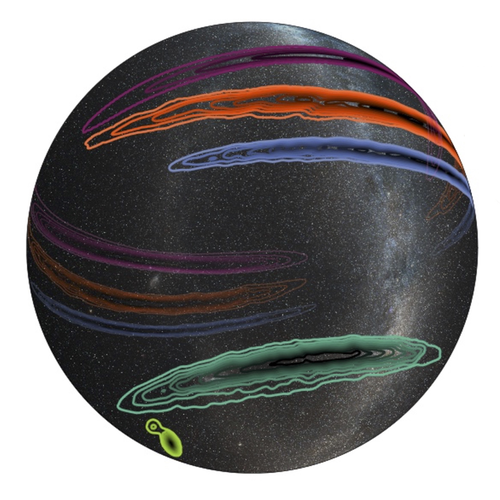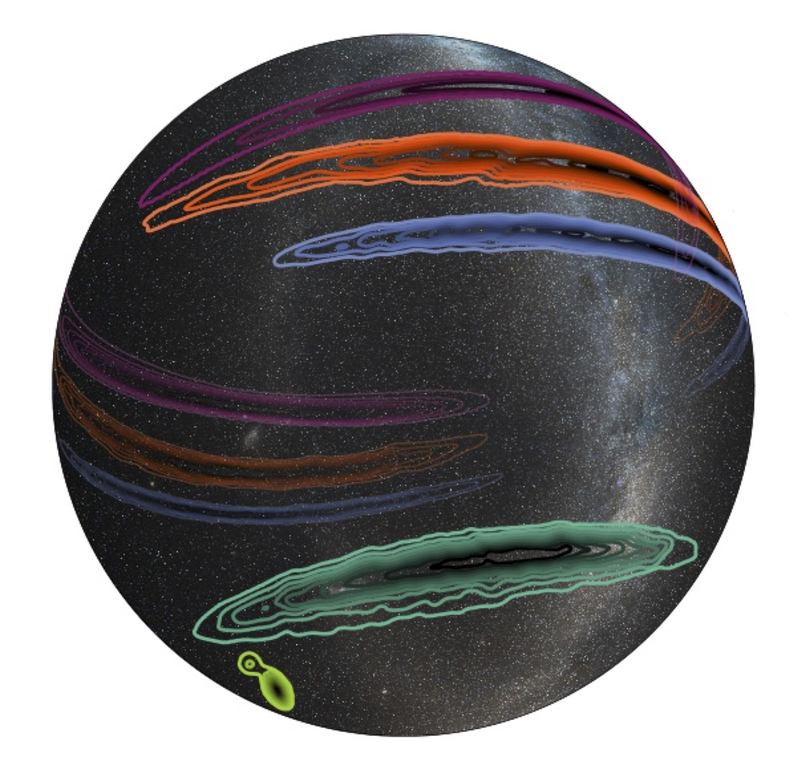Three-Way Detection of Gravitational Waves
The Laser Interferometer Gravitational-Wave Observatory (LIGO) and Virgo collaborations report the fourth detection of gravitational waves, but this time three detectors picked up the signal—LIGO’s two US observatories and the newly upgraded Virgo detector near Pisa, Italy. Observation by all three detectors brings two significant advances: more accurate determination of the location of the source in the sky and the ability to compare the observed wave polarization (pattern of space distortion) with the prediction of general relativity and that of other theories of gravity. (Spoiler alert: general relativity passes the test.)
LIGO’s two L-shaped laser interferometers, located in Louisiana and Washington state, have 4-km-long arms that measure tiny distortions of spacetime caused by ripples of gravitational radiation, which they first detected in 2015. The Virgo observatory has 3-km-long arms, and it re-started operation in August, after a major upgrade.
On August 14, a signal was seen at LIGO-Livingston; 8 milliseconds later, LIGO-Hanford reported a detection; and 6 milliseconds after that, Virgo detected a signal. A statistical analysis by the LIGO and Virgo collaborations suggested that such a multi-site detection would occur in random signals at most once in 27,000 years. The addition of a third detector, the researchers say, greatly reduces the chances of “false positives,” and this increases the sensitivity of the system as a whole.
Comparison with simulations suggested that the waves came from a merger of black holes of about 30 and 25 solar masses, and the signal strength put the merger at a distance of between 1.4 and 2.2 billion light years. By triangulating from the timing of the signals at the three detectors, the team estimated the source location to be within an area of sky measuring roughly 60 square degrees. That’s still a large area—roughly equivalent to the size of Texas on the globe of the Earth—but it is better than a tenfold improvement in localization compared to events detected by LIGO alone.
The team alerted the astronomical community to the detection, but no corresponding signal has been found in any part of the electromagnetic spectrum or in neutrinos. The lack of an optical counterpart isn’t really a surprise, says astrophysicist Coleman Miller of the University of Maryland in College Park. Two such black holes in a close orbit are likely to sweep their immediate vicinity clear of gas and dust, he explains, and the gravitational radiation released by the merger does not agitate what little material remains enough to emit electromagnetic energy.
Analysis of the signal suggests that the black holes were not spinning very rapidly. It’s noteworthy that three of the mergers detected so far involved black holes with a few tens of solar masses and little spin, while one event involved black holes of around 14 and 7 solar masses with somewhat higher spin, says gravitational theorist Frans Pretorius of Princeton University. But he is cautious about identifying patterns in a set of only four detections. Miller is similarly cautious about drawing conclusions but says that it’s consistent with models of the formation of large black holes, in which angular momentum is carried away by material ejected from the original star.
The combination of Virgo and LIGO also allowed a novel, although preliminary, test of the polarization of the waves, a geometrical property that’s related to the way they disturb spacetime. In general relativity, gravitational waves have what is called a quadrupole or tensor form. This polarization means that a wave traveling from left to right, for example, would distort a circle of particles in the vertical plane perpendicular to the propagation direction into, say, a vertical ellipse, then a horizontal ellipse, and then back to vertical again with each wave cycle. In principle, however, gravity theories based on spacetime curvature can have waves of other forms: scalar, in which the ring of particles would expand and contract as a whole; and vector, in which particles would move back and forth along the direction of wave propagation.
LIGO’s two L-shaped interferometers are aligned “back-to-back,” pointing away from each other. This arrangement enhances the sensitivity of the pair for waves coming from some directions but prevents a direct test of polarization. The different orientation of the Virgo interferometer allowed the team to study polarization and show that the data strongly favor a pure tensor waveform over a pure vector or pure scalar form. This is the first direct test of the polarization of gravitational waves, says LIGO team member Deirdre Shoemaker of the Georgia Institute of Technology in Atlanta. Future tests will try to set limits on the proportion of scalar and vector waves in gravitational radiation, she adds, but a complete analysis of the polarization would require detectors set at five different orientations.
The first collaborative observing run of LIGO and Virgo ended on August 25. At the September 27 press conference announcing the new discovery, LIGO spokesman David Shoemaker of the Massachusetts Institute of Technology said that the performance of the LIGO detectors is currently at about half of the design specification and that further fine-tuning should improve the sensitivity. It’s possible, he added, that with both LIGO detectors performing at their best, researchers could see black hole mergers as often as once a week, making gravitational wave observations a reliable astronomical tool.
This research is published in Physical Review Letters.
–David Lindley
David Lindley is a freelance science writer, now retired. His most recent book is The Dream Universe: How Fundamental Physics Lost Its Way (Penguin Random House, 2020).





